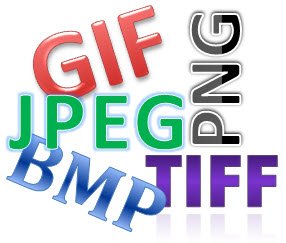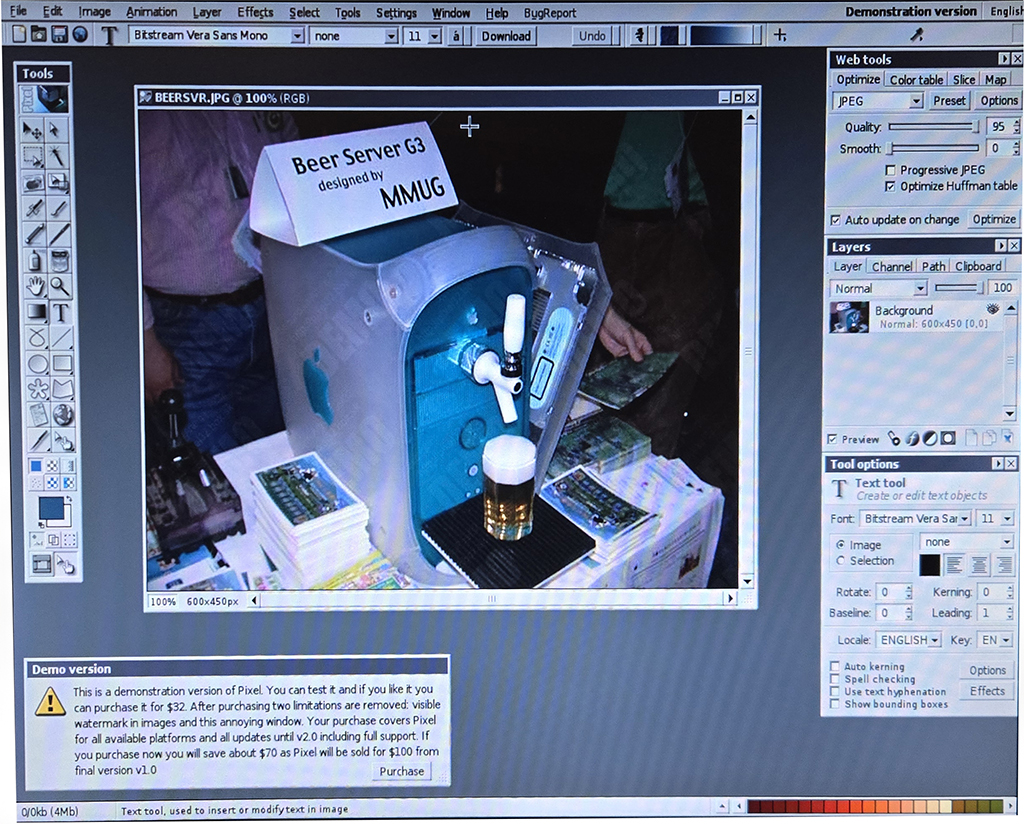| |
DOS Image Viewers [18!]
Summary:
When you think of viewing GIF, JPG, PNG and other image files in the DOS
environment, you may think that there are not a whole lot of image viewer choices.
After all, DOS itself tops out at 16-color, 640x480 VGA, which does not sound
particularly promising for viewing images. However, you would suprised
at the multitude of choices you have (18 viewers are included
in this post!), and the resolutions, color depths
and image rendering quality
that they make available. Read on for all the details.
Post Body:
MS-DOS made its debut in 1981, as the operating system for the the
original IBM PC. Powered by a 4.77 MHz Intel 8088, the IBM PC was
significantly more powerful than its contemporaries, but it was NOT
powerful enough for complex image decoding. This was not an issue
when the IBM PC launched however: the GIF standard would not be minted
until 1987 and the JPEG standard years later, in 1992.
Various forms of DOS remained the primary OS for PCs from the PC's
launch in 1981 until
Windows 3.1 was released in 1993. By then, IBM
PC (and clone) CPUs had evolved from their humble beginnings to the
more powerful 80286 chips (1982), then the 80386 (1986) and then the
80486 (1989).
GIF was well established shortly after the arrival of the 386-class
machines and JPG followed soon thereafter. Windows 3.1 was still years
away, but powered by the explosive growth of the internet and the web,
GIF and JPEG images began to proliferate quickly.
The need for DOS-based image viewers quickly became pressing and
software authors jumped into the breach to meet the need.

There were complications, of course. DOS had no integrated graphics
support other than VGA, which supported a maximum of 640x480 and 16 colors,
and so the authors of DOS image viewers had to
develop and include unique plugins for each video card they supported
(and there were no small number of those!). There was the promise
and the further complexity of VESA, which could allow DOS to display
a huge number of larger resolutions and deeper color densities, but
again, VESA support was unique per video card. The need for card-specific
plugins led to a degree of
complexity in the setup of these viewers that was often beyond the
capability of less computer-literate users (and there was no small
number of those either!).
Complications or not however, prior to the arrival of Windows 3.1, DOS
was king, and the king needed a way to view image files. What were
the king's options? After considering this question for a time, and
with a little prodding/help from my newfound compatriot PhG, I put together
a list of DOS image viewers fielded by the intrepid software authors
mentioned above. Taken as a group, these viewers nicely supported the
machines of the mid 1980s and into the early 1990s, covering the range
from 286-based machines all the way up to Pentium/586-based machines.
Viewers for 8086/88 machines were omitted from consideration (if they
existed at all); they simply did not have the "umphh" to do
decompression of complex image formats like GIF and JPG.
Below is the list, which by no means claims to be comprehensive; it is
just the best that could be unearthed in 2025, nearly 30 years after the fact.
If you are aware of more and/or better DOS image viewers, please leave
a comment to this post and we will update it to include your input,
assuming that the viewers in question can be found, downloaded and tested.
A quick note that will be more fully expounded upon in a later post:
the DOS viewers we tested were head-and-shoulders faster at
rendering JPEG images in particular than their Windows-based peers,
making them the better choice in the early days of GIF and JPG. Many of
these early DOS image viewers featured hand-coded x86 assembly language
JPEG image decoders, giving them a significant performance advantage
over their slower high level language based peers.
OK, with no further ado, here is the list, presented in alphabetic
order to ensure no favoritism creeps in (note that all of the image
viewers on the list are available for download from the DOS archive of
this site):
-
CShow/CSHOW2000: CompuServe Show
(remember CompuServe? :-) ) versions 9.0.4 and 2000 are both
excellent and very capable image viewers.
In both cases, CShow supports the JPEG format and
just about every other
common image format of the day. CShow runs nicely on 286 and later
machines. It is not as fast as some of the others, but it is very
capable. Unlike all of the above, it does an amazing job of dithering
colors on EGA graphics hardware, even for JPEG images, producing a
remarkably good rendering of the image despite the limitations of EGA.
This makes CShow an outstanding choice for 286-class machines. We tested
two versions of CSHOW, v9.0.4 and CSHOW 2000. Presumably the "2000"
version is newer, but aside from user interface differences, there were no
obvious advantages, one to the other
-
DOSView: DOSView 1.5 requires a 386 or better. It supports
all the common image formats of the day, including JPEG. It is fairly
speedy and does a nice job of rendering images seamlessly - no
configuration necessary. DOSView auto-magically determines the graphics
capabilities of the machine it is running on and configures itself
accordingly. However, it does let users list the video modes that
it has determined are available and allows the selection of a mode
other than the default to be used. DOSView can both scale
and convert the format of the images it shows, allowing users to write
out the result. This makes it a lightweight image editor as well as an
image viewer.
-
GWS (Graphics Workshop): GWS 6.1 is a solid choice for almost
any machine from the 286 onwards, but it does NOT support JPEG. It DOES
support GIF, BMP, RLE, TIFF, PCX and more. For 256 color GIF images
(and that is most of them these days) it will dither the colors into
grayscale on EGA and CGA machines. Unlike most of the programs on this
list, GWS is more than just a viewer; it is an image editor as well (as
the word "workshop" in the title might suggest). It will view, scale,
convert, dither, rotate, mirror, crop and more. For image formats other
than JPEG, GWS is a great choice. It is not as fast as the rest, but it
is fast enough. Note that GWS is one of those rare programs that
supports the Windows 4-bit RLE format, for anyone who might be interested in
changing the Windows splash screen! Another post covering the "how to" of
this task will be published at a later time.
-
JView (JPEG Viewer): JView16 0.95 is a JPEG-only image viewer.
Two versions are included in the distribution ZIP file, a 16-bit version
and a 32-bit version. The 32-bit version fails to execute, confusingly claiming that
the real-mode 486DX2/66 that it was being tested on needed to be placed
into real mode (vs. virtual x86 mode)! Despite this oddity, the 16-bit version, JVIEW16, runs
nicely and gets the job done, but for JPEG files only.
-
LWhiz: LWhiz 1.32 describes itself as a little viewer for
big files. It has unique support built in to allow even very large files
(very large for its day!) such as 2000x3000 to be effectively viewed on a
DOS PC. LWhiz is written in 100% x86 assembler, which is reflected in its
speed of operation - LWhiz is fast! Many of the viewers on this list are
menu driven - users have to navigate to the directory of interst and then
graphically select the file of interest;
not so for LWhiz, which can be used in command line mode to load specific
files, one at a time, for example, "lwhiz filename.jpg".
-
LxPIC: LxPic 7.3 bills itself as a "small, fast image viewer" and
it lives up to that billing. LxPIC will run on a 286 or later machine,
but if that machine is equipped with EGA or CGA
graphics, like CSHOW it will drop to grayscale and dither the colors, at which it
does a reasonable job. Like PV and PictView (both detailed below), LxPIC
automatically determines the video capabilities of the machine it is
running on and configures itself accordingly. Like many of the programs
on this list, LxPIC supports most of the common image formats of the era. Despite the
fact that ANY form of image rendering on a 286 is not fast, LxPIC gets
the job done, making it a good choice (along with CShow and PV) for
such a machine. On a faster and more capable CPU than a 286, LxPIC is a
great choice.
-
Ombra: Ombra 7.17 is a small, multi-format image viewer for DOS.
It supports GIF, TGA and PCX, but sadly not JPEG. Ombra requires VGA at a
minimum, and SVGA or VESA to display anything at resolutions above 320x200.
-
PixView: PixView 2.3 supports most common image formats. It
has a very nice GUI interface, which must be used to navigate the directory
structure to the file(s) of interest. PixView requires a 386 or better
and is a 32-bit DPMI application. PixView's clean interface and fast image
rendering make it a personal favorite here at retro-computing.com.
-
PV (Picture Viewer): PV 2.78 works well on 286 machines but it
should be noted that most 286-based machines came with CGA or EGA
graphics, which heavily restrict the colors that can be rendered. PV
supports most common image formats and renders images very quickly. It
too auto-magically determines the video card and thus the support
needed, which makes use of PV somewhat seamless - "no muss, no fuss".
PV has quickly become a new favorite - it runs on almost all the
machines in the retro-computing.com lab, renders images very quickly and supports most formats.
All in all, PV is a very good choice.
-
PictView: Perhaps confusingly similar naming to PV, but
also very similar operation. However, unlike PV, PictView requires a 386 or
better. It too supports most common
image formats, and also auto-magically determines the video card in use, configuring
itself to take maximum advantage of it. All in all, PictView is a very good choice
if you have a 386 or
better.
-
Pixel: Pixel 4.8.1 is nothing less than a tour-de-force, a DOS image viewer and
editor that has been called the Photoshop of the DOS world. This may be
a bit of an exaggeration, but Pixel is a highly capable image editor.
The user interface looks remarkably similar to Photoshop's (see the screenshot immediately below),
and the capability set interfaced by that GUI is incredibly far reaching. Pixel is without question
the most powerful DOS image editing program reviewed in this list.

This is great BUT all that capability comes at a cost - Pixel 4.8.1 is heavy and slow on all but
the most powerful DOS machines. Even on retro-computing.com's 486DX2/66 with 16 MB of RAM and
buckets of free disk space (a generously equipped box for DOS/Win-era machines),
Pixel really struggled. Pixel is a 32-bit
application that needs DPMI, but with that in place, it can take advantage
of all of the RAM on the machine. Even so, getting it to open even a
moderately sized image file caused minutes of disk thrashing, to the extent that
it appeared for a time that the application had wandered off into free space
("gone for a spacewalk" :-) ). Finally however it came back to earth and displayed the image.
After that, but with a whole lot more thrashing, it was possible to cleanly quit the application.
Pixel places the display into a graphics mode before loading up, and specifically those modes
must be VESA modes. It failed to run at all until the
video card's VESA driver was loaded. Then Pixel took off. Unlike many of the others, Pixel does
not automatically determine the video mode to use, and so its first user
interaction is a rather sparse prompt asking for the mode to use. There is no ability to
list the available modes and select one from this prompt,
and any input other than a valid mode number causes
Pixel to take an exception and crash. Happily, a program called TESTPX.EXE is
included in the distribution directory. TESTPX.EXE, when ran, lists
all the available modes. Mode 278 corresponded to 1024x768x64K colors on the 486DX2/66
and after that was selected, Pixel thrashed the hard drive a whole lot more and
finally presented its beautiful full screen GUI (with its own window manager of course).
Going through all the available menu selections, the comments about Pixel being the
Photoshop of the DOS world seem well justified. Pixel looks to be extraordinarily
powerful.
Pixel is extremely powerful, but as mentioned above, it is also extremely heavy and extremely
slow on all but the
most powerful of DOS boxes.
We recommend a 486DX4/100 or faster machine, with 32 MB of RAM or more
and lots of free disk space as the minimum baseline for running Pixel. Anything less
will leave you frustrated in the extreme as Pixel thrashes and thrashes and thrashes.
-
QPEG: QPEG 1.5e requires a 386 or better and supports most common
image formats. A complex and detailed .cfg file MUST be correctly
configured for the machine's video card in order for image rendering to operate
correctly, BUT a large number of preconfigured CFG files for the
most common video cards of the day are included, easing this task. QPEG
features a nice and fairly fast thumbnail capability, although it shows
only one image at a time vs. a directory catalog type approach.
QPEG delivers fairly fast image rendering, powered by an x86
assembly language implementation. All in all, it is a good viewer, and
was in fact the only one I used for DOS from the delivery of my first PC in
1993 until just recently.
-
QPV: QPV 1.7e is the successor to QPEG. It too requires a 386
or better, supports most common image formats and has a nearly identical
look and feel to QPEG, sharing all the same strengths and weaknesses. If
you are going to try QPEG, try QPV instead. It is essentially the later, better
version of QPEG.
-
QView: QView 1.03B is a 286 or better, real-mode DOS image
viewer. It has a more capable sibling, QViewPro, which can take advantage
of 386 protected mode capabilities. QView supports all common image
formats except JPEG, has a clean simple GUI and is amazingly
fast at rendering images.
Its one drawback is that it requires VGA - CGA and EGA are not supported.
QView is a good choice for any VGA-equipped machine, and it is a particularly good
choice for lower powered machines (think 286 and low-speed 386SX boxes!).
-
QViewPro: QView's more capable sibling, QViewPro requires
a 386 or better AND a hefty amount of
XMS in order to run at all. QViewPro refused to run on our 8 MB 386
machine, claiming that there was not enough memory! On our 16 MB
486DX2/66, it ran well however. As you may have guessed, QViewPro is a 32-bit
application that requires DPMI in order to display anything. Loading
the application itself takes some time, but once it is loaded, QViewPro
feels quite snappy when rendering images. QViewPro supports all common image
formats and has a wide range of image options that can be invoked after
the program is loaded and running. If you have a generously equipped
386 or better, QViewPro could be a very good choice.
-
SEA: SEA 1.3 bills itself as the world's
fastest DOS image viewer, and largely it lives up to this billing.
Given its small footprint, it has a more limited capability set than
many of its peers mentioned here in this post, but it is well worth
the effort to check it out. You may be surprised by what such a small
package can do, and how quickly it can do it! SEA does feature a truly
annoying nagware screen that appears both when the application is
started and again when it is exited, and so SEA is less than a
favored application here at retro-computing.com.
-
ShowJPG: ShowJPEG 2.81 is an exceptionally
fast DOS JPEG viewer. As the name suggests, ShowJPEG supports only the
JPEG image format. Unlike many of the viewers on this list, it can be
used in command line mode, for example: "showjpg filename.jpg".
-
VPic: VPic 4.1 supports all machines from 286 and up. Despite
this billing, and while it runs on a 286-class machine without crashing, it
does not seem to be able to render images on such machines, and so it
is not a good choice for this class of PCs. VPic also does NOT support
the JPEG format, and so if you want to view JPEG files, it is not a good
choice either. Finally, in our testing, VPic did a very poor job of
rendering almost anything on our 386-class machine and an even worse
job on our 486-class machine. As a result, we cannot recommend VPic for
any image viewing use.
That brings us to the end of this list of DOS image viewers. As
mentioned at the outset, this list is almost certainly not comprehensive, but
it does represent the best set of viewers still available for download
and test in 2025! Other image viewers
not on this list were evaluated but not included due to (a) significant bugs, (b) lack of
general applicability (for example, PCXView ONLY supports the PCX format)
or (c) unavailability... several promising sounding viewers ended in dead
links and no other sources that could be found.
Per the comment above, if you know of other viewers that are still available,
useful and of interest,
please leave a comment on this post and after download and test, we will
update this list.
In the end, the viewer or viewers you may choose to focus on will depend
heavily on the class of machine you have, the amount of RAM you have,
the type of images you wish to view and of course the graphics
capabilities of your machine. As a general recommendation, if you have a 286-class machine, CShow is
likely your best choice, followed by PV. If you have a 386 or better
machine, you are spoiled for choice - try several (or all) of these
viewers and decide which one you like best.
Enjoy image viewing the DOS way!
|






